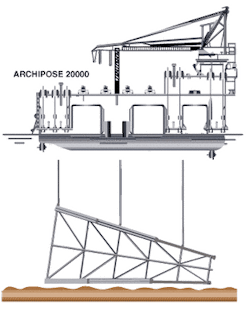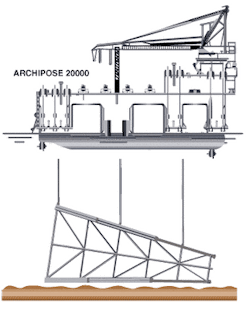Heavy deck removal vessel under review for Frigg, Ekofisk
About 6,500 offshore petroleum industry installations worldwide will likely have to be decommissioned over the next three decades. Many of these are in the North Sea and North Atlantic, where the platforms are generally larger, and environmental conditions rank among the most severe in the world. However, the techniques for removing these structures are far from finalized.
Several consortia are responding by developing concepts for new, purpose-built vessels capable of removing large decks and jackets in a variety of situations. One of the newer concepts is actually an updated version of the U-shaped Archipose, developed nearly 20 years ago by Doris Engineering to undertake installations offshore of decks and jackets.
A consortium is being formed to bring together companies with the skills required. These range from removal of units at sea to a storage site onshore for deconstruction, waste treatment, and disposal. Opportunities for selling parts of the removed units for re-use will also be explored. The consortium will include companies specialized in environmental issues and will be in place some time this fall.
Doris Engineering, members of the consortium, estimates construction time for theArchipose at 26 months, for a potential outlay of $140-200 million, depending on the equipment installed, such as dynamic positioning, cranes, and living quarters. The final choice of equipment will depend on the market situation.
Liftout vessel
The vessel is a semisubmersible vessel in the shape of a horizontally arranged "U," capable of removing decks weighing up to 20,000 tons from typical North Sea eight-leg steel jackets, or smaller decks from standard four-six leg jackets. It is designed to undertake this task in a single lift, thereby cutting the time and costs associated with traditional modular deck removal exercises via a derrick barge.
The designers say the newer derrick barges have been designed with a 12,000-14,000 ton lift capacity, but this is still at least 6,000 tons below what theArchipose would offer, if built. Unlike derrick barges, the Archipose lifting operation would not require structural reinforcement to the deck, because the lifting and transportation deck supports employed are the permanent supports on the jackets.
Construction costs
Archipose 20000's construction costs are claimed to be below those of a 12,000-ton derrick barge. The vessel's dimensions are relatively small, with reduced mechanical equipment requirements, therefore the maintenance cost should theoretically also be lower. The concept is adapted to current North Sea deck and jacket designs. Inside the barge's U-shaped slot is area most of the operations will be performed.
The shape allows the barge to be positioned around a jacket and to lift the deck frame from there onto a cargo barge or to be delivered at an onshore site, the designers point out.Archipose 20000 is self-propelled, and the designers say it will be able to assist mooring winches during positioning over the jacket.
The upper deck scantling, allied to the barge's stability, would allow a crane to be used for handling/lifting operations from the top of the barge. This would permit the barge, for example, to cut piles. The barge's design was reviewed and pre-certified by Bureau Veritas in 1989. The key dimensions are:
- Length of 170 meters
- Breadth of 98 meters
- Bow height of 60 meters
- Stern height of 45 meters
- Pontoon breadth of 16 meters
- Operating and transit draft of 20 meters
- Standby draft of 27 meters
- Light weight of 60,000 tons
- U-slot width of 52 meters
- U-slot length of 105 meters.
Typical lifts
The vessel is designed to lift a 20,000-ton deck with a center of gravity 46 meters above sea level. The lifting points are at the deck's eight legs.Archipose has eight load beams, which are retractable and can be adapted to any pattern and width of deck. They are also designed to cope with all the deck's static and dynamic loads, as well as external loads incurred during transportation.
Onboard equipment includes a 1,600-ton revolving crane on the bow, with allowance for a similar crane on the other side of the bow. This crane can drive piles above or below water through a Menck 1700 underwater hammer.
The vessel's self-propulsion and dynamic positioning are supplied through four thrusters, one in each corner.Archipose's deck area is around 2,800 sq meters, with a helideck that can handle all aircraft up to Boeing Chinook size, according to the designers. There would be accommodation for up to 460 personnel. The vessel's 16-point mooring system would be integrated with the DP propulsion system to relieve loading during storms.
Removal sequence
The designers describe a typical removal sequence as follows: To remove a deck from a jacket, theArchipose is first deballasted until its draft is around 20 meters (transportation draft), then towed to the platform location. Once moored near the jacket, the vessel is pulled around and over the jacket using its mooring winches - the position is such that the deck legs are in front of the loading beams.
Slowly, theArchipose is deballasted until the load beams come into contact with the deck legs. It is then deballasted at speed to permit fast transfer of the deck weight from the jacket. The vessel can move away from the jacket via its winches and subsequently take its load to a cargo barge or an inshore site. There, it would transfer the deck through deballasting.
Doris claims that vessel, fitted with a 1,600-ton revolving crane, could be built for $160-200 million, depending on the location of the fabrication yard. Construction time should be around 26 months. The vessel could also be used for construction of new platforms or for support during hookup operations.
Despite the upsurge in North Sea abandonment predicted from 2003, the consortium will not consider a speculative newbuilding. It wants a guaranteed program of decommissioning two to three years ahead before making any commitment.
At this stage, the likeliest possibilities are in the Norwegian North Sea, where theArchipose 20000 was recently qualified by Phillips as being compatible with the weights, dimensions, and elevation of the center of gravity of the decks to be removed from Ekofisk. Doris also has been awarded a conceptual study by TotalFinaElf to remove the Frigg TP 1 topsides.
TP 1 is a concrete platform in 104 meters water depth with two columns supporting an 8,350-ton deck. Basin model tests were performed late last year, with the final report being submitted this January. The conclusion was that the vessel would be suited for this operation, despite being designed initially for decks on jackets.
Jacket removal
Doris is also adapting the concept for removal of jackets, again weighing up to 20,000 tons. Jackets present more of a problem than decks, as theArchipose is not designed to lift jackets straight out of the water and onto a cargo barge. Doris is working on compromise scenarios, but not all are applicable to the North Sea.
The first proposed method involves using the vessel's de-ballasting capabilities to lift the jacket in one operation, then towing it to a disposal site free-hanging in the water (with lateral connections and supports). The advantages of this approach include minimal preparations for the jacket, limited requirements for added equipment onboard the lift vessel, and relative quickness of the operation.
The downside is that the jacket could only be raised by 23-24 meters. For a jacket installed in 100 meters water depth, the resultant draft would necessitate a towing channel of over 80 meters depth to the jacket's resting place. This may be an option if the jacket could be deposited in an oceanic trench, but it would not be acceptable in the North Sea.
A second option would be to lift the jacket as high as possible in stages (15 meters at a time) in order to reduce theArchipose jacket draft to a minimum. This could be done either through a combination of successive de-ballasting operations and temporary seafastenings, or through successive winching operations with temporary supports on the vessel's retractable loading beams. Either method would allow partial cutting and dismantling of the jacket onboard the vessel. Disadvan-tages are the cost of the ancillary equipment and longer duration out at sea.
The third method studied would involve toppling of the jacket below theArchipose, then lifting it from the seabed in its new horizontal position via winches, followed by tow-out to the disposal site. The equipment involved would be lighter than it would be for option two. However, divers and remotely operated vehicles (ROV) would have to be brought in for the underwater operations.
Control of the jacket during toppling could also prove problematic, and large drag forces would follow during towing. The latter, however, could be addressed through increasing theArchipose's thruster power.
Jacket geometry
A recurring problem with jackets relates to their size and geometry, rather than structural weight. The tapered shape of most jacket bottom sections is generally too wide to be easily accommodated through the vessel's U slot. The same applies to jacket length. Therefore, Doris proposes cutting the jackets into two or three sections - either on site prior to removal or during the removal operation, with the jacket in its elevated position. This method would be the simplest for direct transfer to the disposal site, but would also be the most expensive, due to the extent of the associated marine operations.

